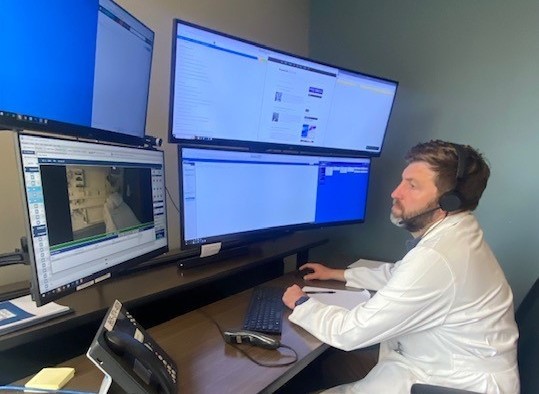Imagine your loved one has been admitted to the hospital and is in critical condition. In addition to getting the best medical care possible, you want to be assured they are in the most capable hands and under constant, watchful eyes. Now, with the help of modern technology, critically ill patients at Covenant Health’s Fort Sanders Regional Medical Center are receiving an extra layer of care through tele-ICU services, a partnership that was introduced at the hospital in July 2021.
One year since being implemented, the beneficial effects of tele-ICU services have been both measurable and extraordinary.
“Our job is to help people during their most critical moments,” says Corey Cudzilo MD, intensivist at Fort Sanders Regional Medical Center. An intensivist is an internal medicine physician with additional training in pulmonary and critical care.
“People are in our care during the worst experiences of their life. Sometimes we are able to get them better, and that is always the goal. But for certain, we are there to do everything we can, every step of the way. These tele-ICU services use technology to provide more comprehensive, continuous care for our sickest patients.”
A Look Back
Tele-ICU services have shown to improve patient outcomes and overall quality of care. Fort Sanders Regional was the first hospital in the area to introduce this new layer of care in 2021, followed by the other eight acute-care facilities in the Covenant Health system.
Virtual Care Operations
It’s important to note that the clinical team at the bedside is caring for the patient as they always have. Tele-ICU services provides video and audio capability in the patient’s room. Clinical staff can push a button and instantly speak to a specialist who is off-site. In addition to being available for consultation, the intensivist uses tele-ICU technology to monitor patient information from the physician’s remote location.
A team of physicians operates from a Knoxville-based tele-ICU operations center that enables consultation and patient monitoring around the clock. Critical care nurses and physicians work “virtually” alongside hospital staff to proactively evaluate the hospital’s sickest patients and anticipate medical needs before they become urgent.
Putting Patients First
Dr. Cudzilo has been an intensivist at Fort Sanders Regional since 2014. He says, “Tele-ICU is a virtual intensive care unit that allows us to have access to all the ICU-level beds in the entire Covenant Health system, which was not possible before this technology was available.
“We are seeing real-time data including vital signs, labs, plus video and sound capability with high-definition and high-resolution, for an unmatched and unprecedented amount of monitoring,” he explained.
“We are able to communicate with nurses, pharmacists and other bedside physicians to help assess a patient in the moment and provide recommendations and consultations in a timely manner.”
At the tele-ICU virtual operations center, Dr. Cudzilo applies his patient-care expertise as he normally would, except instead of being at the bedside, he watches monitors that display data for multiple patients at several locations. He offers virtual support to Covenant Health’s critical care bedside teams, including those at his home base, Fort Sanders Regional.
A High-Level View of Information
“It’s a very different experience as a physician,” he says. “At the bedside, you focus on one patient at a time. You review the data for that person, make a plan for the day, and move on to the next person. When working tele-ICU shifts, you are monitoring multiple patients’ data at once. You can see information from a ‘30,000-foot view,’ and support the bedside care team, who is there keeping close watch.”
Treating the Sickest Patients
Dr. Cudzilo has seen positive results using tele-ICU services with patients who are suffering from Covid-19 and complications related to the virus.
“We saw patients in our sister facilities who were admitted to the ICU because of Covid. As their staff dealt with ventilators and other complex treatments for these very sick patients, they had the virtual intensivist on screen – ‘virtually’ in the room – to consult and to work in tandem in treating these patients. We were able to provide recommendations for treatment immediately. In other cases, if not for this technology, you might not have a hospitalist or intensivist so quickly available to so many patients in outlying areas.”
Data Matter
Dr. Cudzilo explains the tele-ICU capability allows the physician to view data sets in a new way. “We can see data across our entire ICU or our entire health system, compile that data into meaningful info that can be used to make real change, standardize best practices of care and ultimately best serve our patients,” he says.
“There are practices and measures in medicine which can apply to all patients receiving intensive care,” Dr. Cudzilo explains. “We can look at blood sugar control, preventing blood clots and ulcers, and other best practices that we can apply at all hospitals. We are still in the early stages of figuring out what tele-ICU technology can do for our system. The augmentation of the bedside team and high-level view of data and system improvements is just the beginning.”
This information is provided by the marketing department of Covenant Health.

